How Big Does a Black Sea Bass Get
Wreckfishes: Family Polyprionidae
Species : Stereolepis giga (Ayres, 1859); from the Greek words sterolepsis (firm scales) and gigas (giant). Although called a bass, bass-like might be more appropriate since they are considered members of the family Polyprionidae—Wreckfishes.
Alternate Names : Commonly called black sea bass in our fair state although I like the more impressive names given by the French—bar gigantesque and barréan géant. At one time called Jewfish, California Jewfish, ocean hippo and freight train. Called mero pescada or pescara in Mexico.
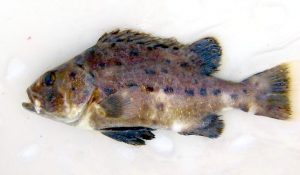
A juvenile giant sea bass with typical spots
Identification : Like many fish, the looks change with age, an all too common trait also common to "Pier Rats." Adult fish are bass-shaped, heavy and robust. Colors are dark gray or dark brown with black spots on sides (that fade after removal from water), paler below. More spines than soft rays in dorsal fin; caudal fin slightly indented in adults. Teenage fish are brownish to dusky. Juvenile fish (to about 6 inches) are perch-shaped, bright red with black spots, and with very large pectoral fins.
A good description of the differences between juvenile and adult is given in California Fish and Game, Volume 6, Number 1, January, 1920. "One of the most picturesque fishes of Southern California, well known and appreciated by sportsmen and commercial fishermen alike, is the giant black sea-bass or California jewfish, Stereolepsis gigas Ayres. It is a common sight to see one of these huge fishes hung up by the jaw before fish markets and on pleasure piers, surrounded by wondering tourists. But although over a million pounds are landed yearly in the markets, the fish caught all range in size from about three to six feet in length. The commercial fishermen never admit having seen a jewfish less than one and a half or two feet in length, and all declare them to be dull black in color and withoiyt markings, as are the larger ones. Imagine our surprise then, when we discovered that certain pretty little bass-like fishes from the hails of the boat "Albacore" were the young of the jewfish! These resembled the huge, ugly adults neither in form, color, nor markings… the younger specimens are a rich brick-red in color and market with conspicuous dark brown or black spots irregularly scattered over back and sides. There are also white or pale yellow splashes here and there on the body, especially on the throat and ventral side of the tail. The vertical fins are black with conspicuous transparent edges, the ventrals black, and the pectorals pale or transparent. As the fish grows older the body color darkens and the spots become indistinct until the whole color is a uniform dark brown or dull black, except for the light patches on the throat and ventral surface of the tail, which often persist even in the larger adults. All the fins become black except the ventrals, which, though black in the young, are lighter than the pectorals in the adult, showing white membrane between the black fin rays."
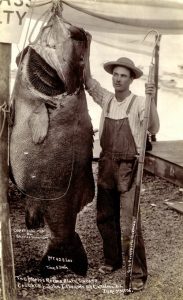
424-pound Giant "Black" Sea Bass taken at Avalon
Size : Length to 8.9 feet and over 600 pounds. The California angling record weighed 563 lb 8 oz and was taken at Anacapa Island in 1968. The diving record fish weighed 545 Lbs 0 oz and was taken Santa Cruz Island in 1968. These fish reach an old age: a 7-foot fish found beached at San Clemente weighed 539 pounds and was about 60 years old; another fish, weighing 435 pounds, was 72-75 years old. They mature at age 11 to 13 years, 50-60 pounds.
Range : Oaxaca, southern Mexico, Gulf of California, Pacific coast of Baja, California (including Guadalupe Island), to Humboldt Bay, northern California. Uncommon north of Point Conception although they once were fairly common in Monterey Bay. One record from Humboldt Bay.
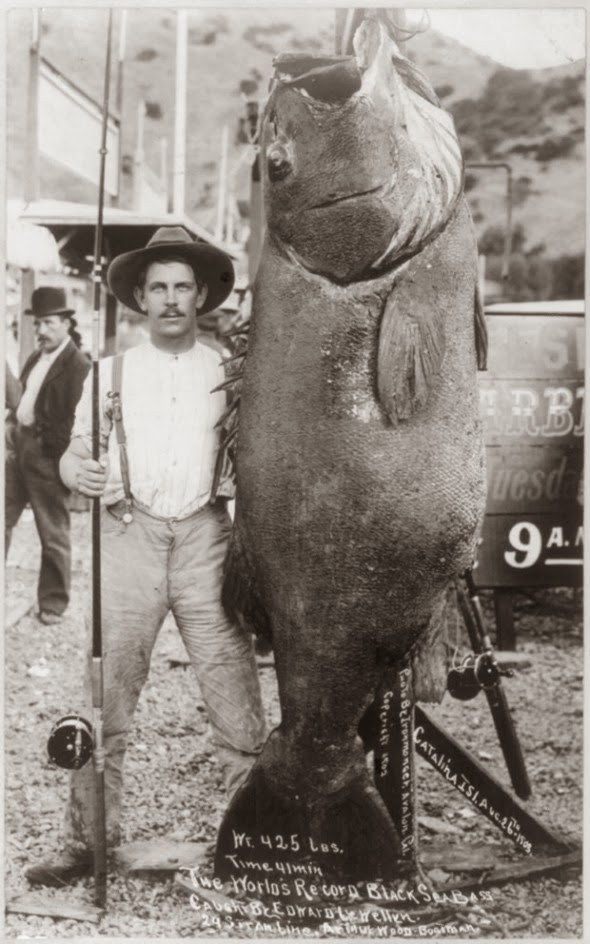
425-pound Giant (Black) Sea Bass taken at Avalon
Habitat : Primarily bottom dwellers found in rocky areas, outside kelp beds, and along drop off areas. The young are common near shore. Depth varies from fairly shallow to 100 feet with the larger fish typically in deeper water. Recorded to a depth of 180 feet. Their diet includes a myriad of fish species (especially small rays and skates) as well as crabs, lobster, mantis shrimp, squid, and octopus—basically almost anything that swims or scoots around the bottom where they're hanging out.
Piers : There was a time in California when giant sea bass were a fish that was pursued by those filled with hope—and equipped with heavy tackle. Most oceanfront piers in SoCal reported at least a few really giant sea bass (called black sea bass then) that exceeded several hundred pounds in size.
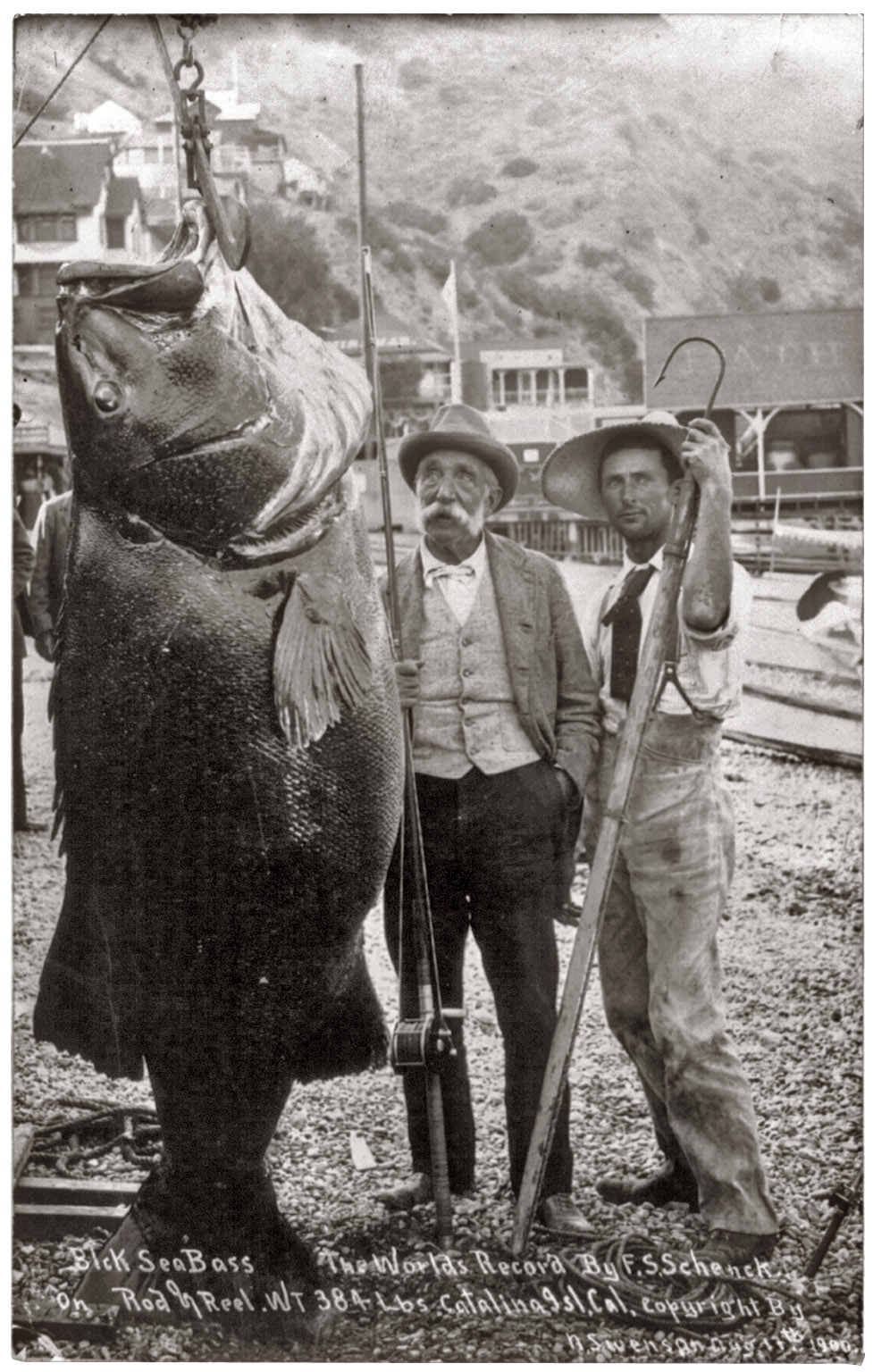
384-pound giant (black) sea bass taken at Avalon by Franklin Schenck in 1900
Shoreline : Rarely hooked by shore anglers.
Boats : Once a prize sought out by southern California anglers, especially "barge" fishermen; now illegal to keep.
Bait and Tackle : Illegal to take.
Food Value : None since they're illegal.
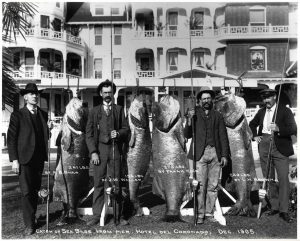 Giant "Black" Sea Bass taken from the Hotel Del Coronado Pier in 1905
Giant "Black" Sea Bass taken from the Hotel Del Coronado Pier in 1905
Comments : Though once fished to almost extinction, a fact that required a prohibition on take, they appear to be making a good comeback. Each year seems to see more and more of the large fish hooked—and returned—from piers.
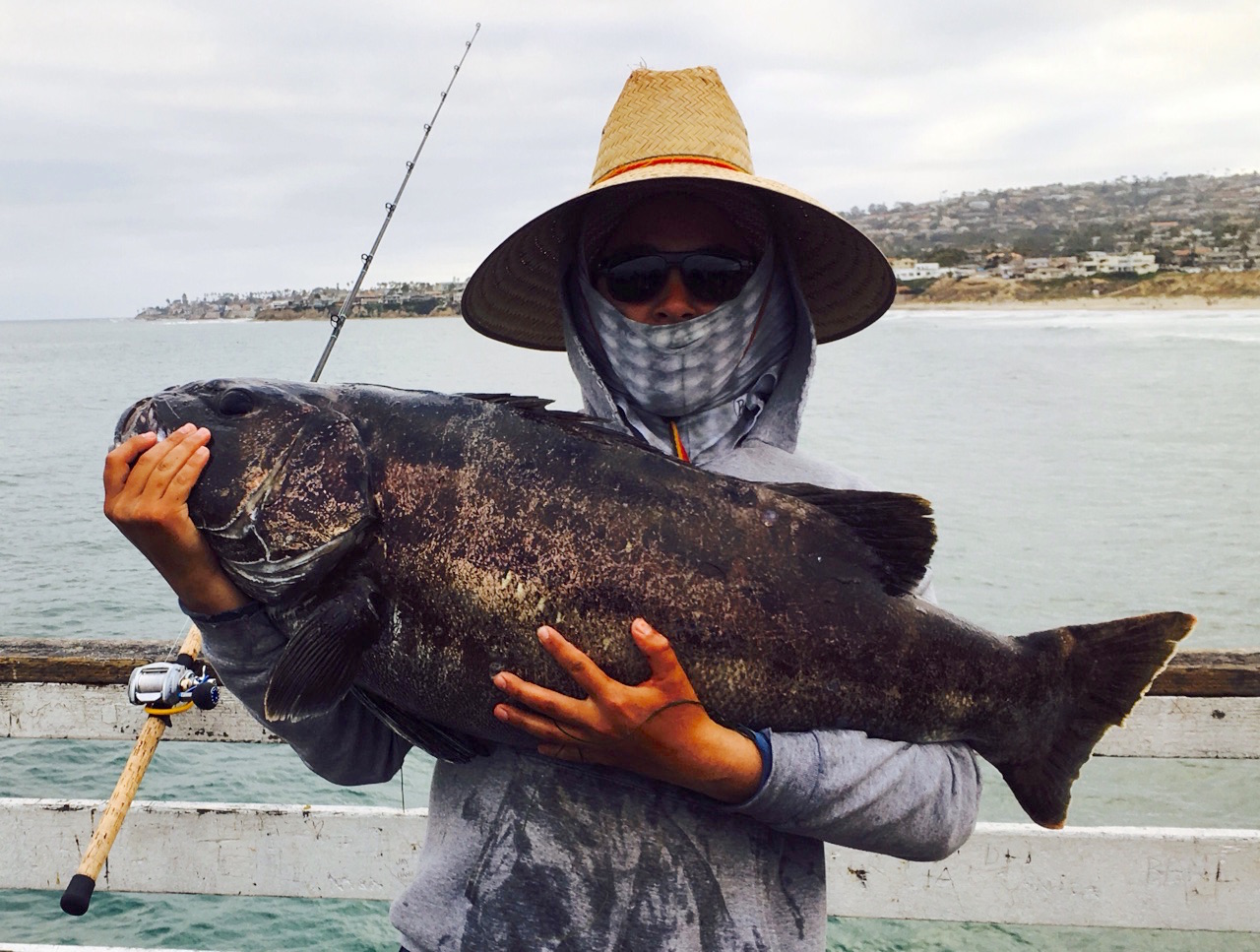
A giant sea bass at Crystal Pier in 2017. This is the wrong approach. Net them, bring them to the pier, remove the hook, and put them back in the water with a net. Do not hold them up like this.
The largest number appear to have been seen at the Oceanside and San Clemente piers but almost every SoCal pier sees a few fish each year (albeit most of these are young fish in the 30-60 pound range). We've seen several of these large giants slowly swim by, practically under our feet, while fishing from the Green Pleasure Pier in Catalina. The water is only about fifteen feet or so deep, crystal clear, and the sight never fails to amaze.
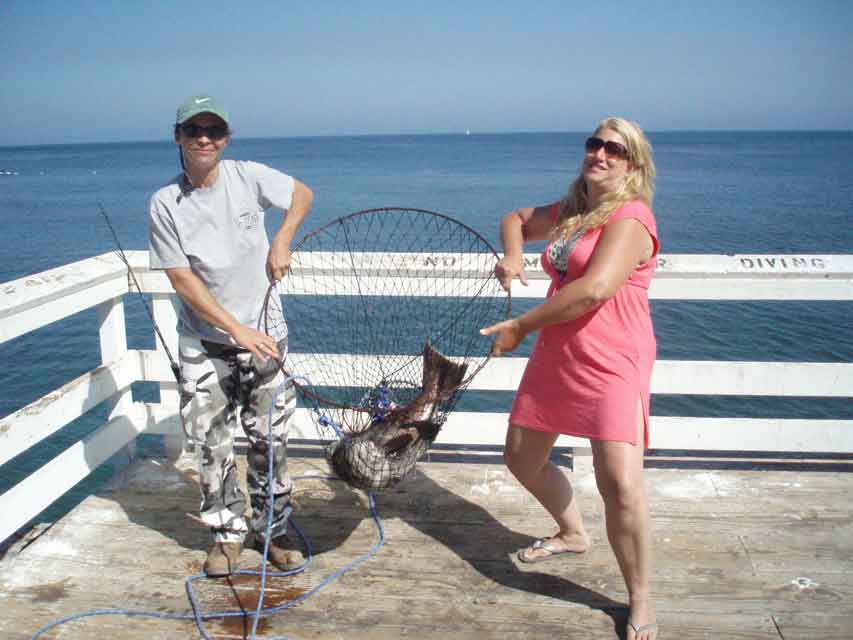
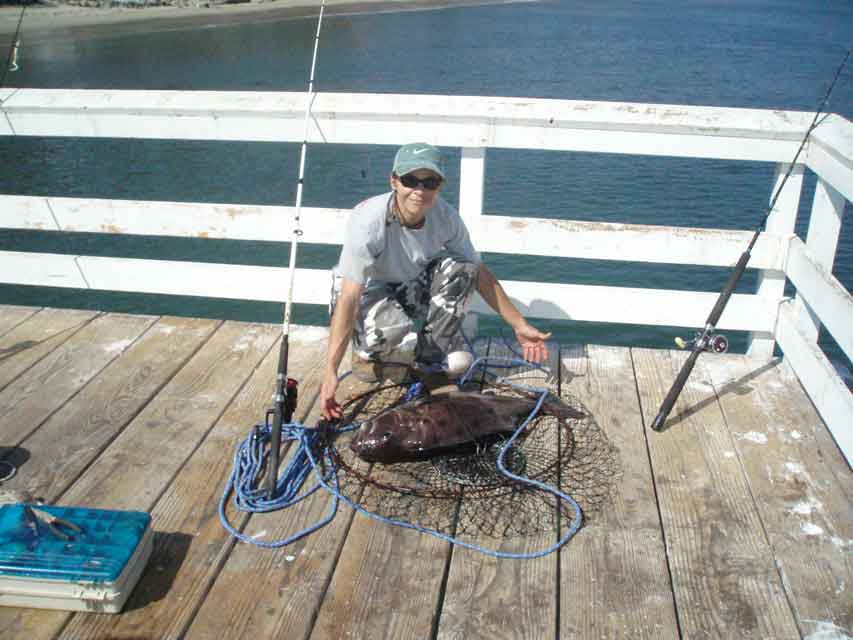
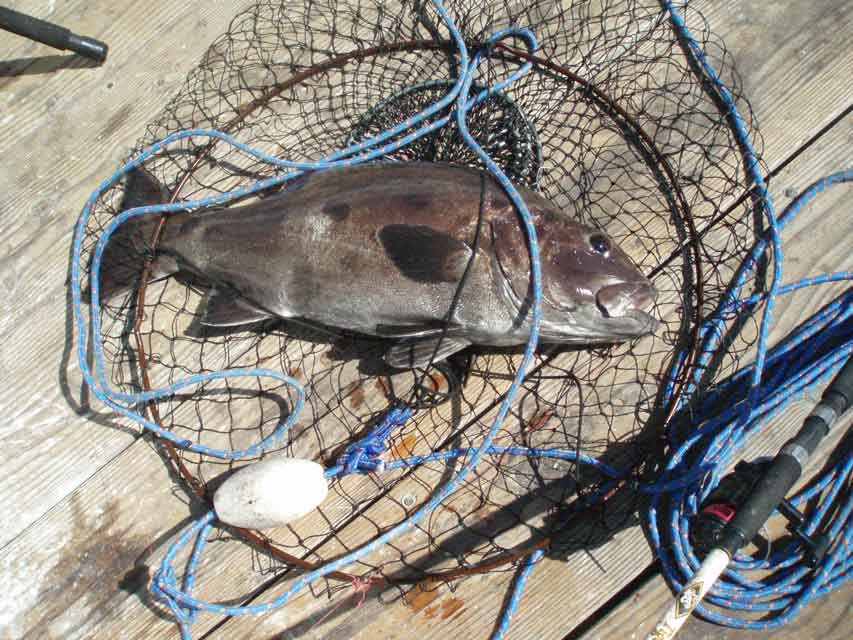
A young giant sea bass caught and returned to the water at the Paradise Cove Pier in Malibu in 2008. Technically the bass should not have been removed from the water. But how do you remove the hook and terminal tackle of a hooked fish? At Oceanside the regulars will climb down from the pier and remove the hook but it's very dangerous.
Although increasing in numbers, some studies still show the comeback to be taking longer than expected due in large part to toxins (especially DDE and PCB) that have been found in examined fish. The big fish spend much of their time near the bottom and many of the bottom lurkin' species they eat contain toxins themselves. These toxins can affect everything from development of the larvae to normal reproductive behavior including (possibly) changing males into females (just say no Gabby/Gabrielle). It's a tangled web we've spun in our local waters. Due to over fishing, they are currently illegal to keep in California.
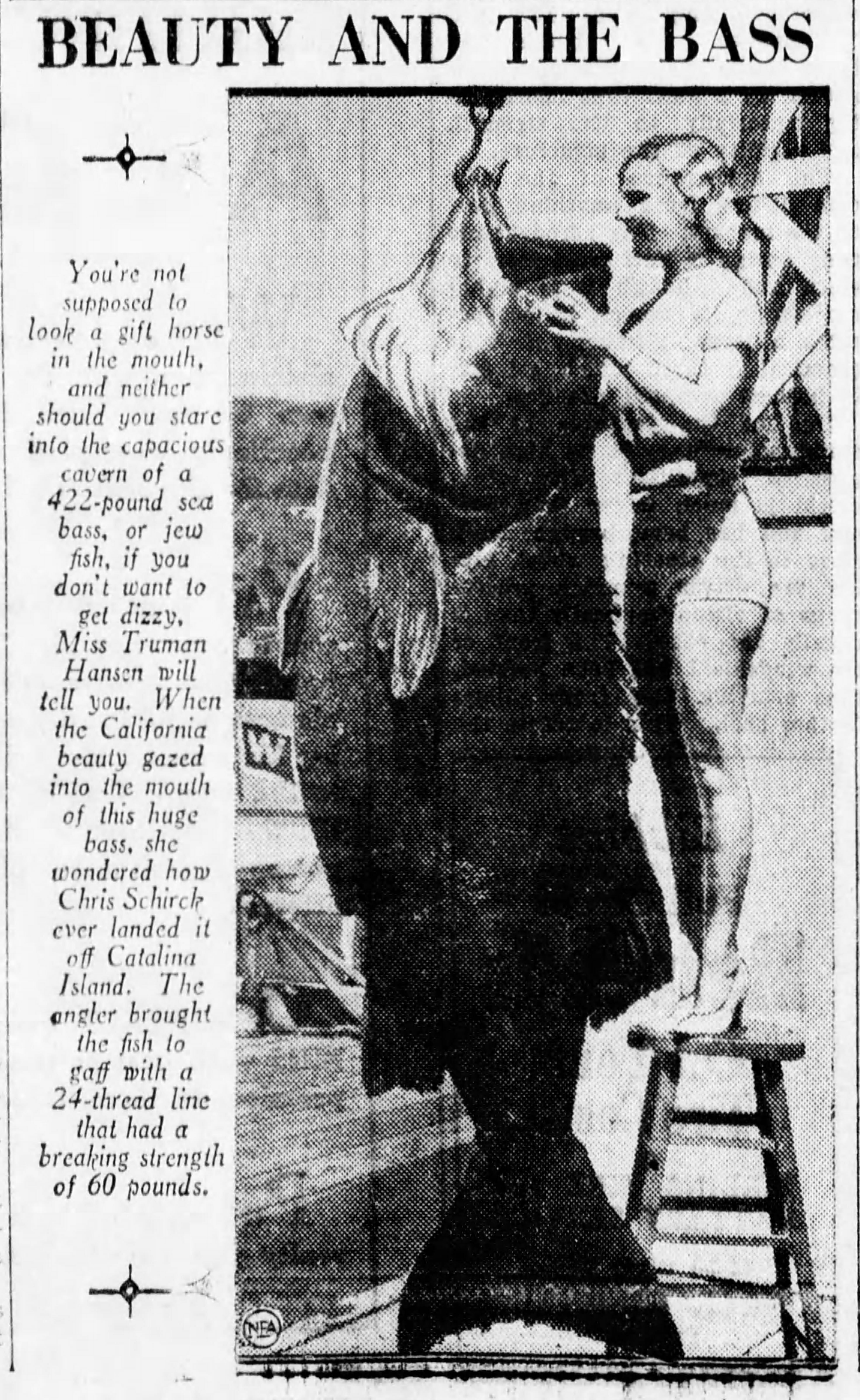
—Santa Cruz Evening News, August 8, 1934
Giant (Black) Sea Bass — In the early years there were an amazing number of large bass caught and many pier regulars specifically targeted the giant bass with special equipment.
≈ 600 Lbs. — Manhattan Beach Pier, 1929
Source: Manhattan Beach Historical Society
≈ 500 Lbs. — Point Mugu Fish Camp Pier, Frank Kubota, June 19, 1925
Source: Oxnard Daily Courier, June 19, 1925
485 Lbs. — Stearns Wharf (Santa Barbara), Joe Foxen, June 21, 1919
Source: San Francisco Chronicle, June 21, 1919
480 Lbs. — Southern Pacific Wharf (Newport Beach), J. S. Stewart, March 12, 1918
Source: Santa Ana Register, March 18, 1918
465 Lbs. — Redondo Wharf, E. H. Borhing, November 12, 1905
Source: Los Angeles Times, November 12, 1905
453 Lbs. — Stearns Wharf (Santa Barbara), R. A. Hendricks, October 22, 1925
Source: Santa Barbara Daily News, October 23, 1925
452 Lbs. — Balboa Pier, Carl Sandino, May 12, 1930
Source: Santa Ana Register, May 13, 1930
435 Lbs. — Newport Pier, "New Jersey man," 1937
Source: Personal communication, Patrick Kennedy, Baldy's Tackle (1990)
428 Lbs. — Manhattan Beach Pier, 1923
Source: Manhattan Beach Historical Society
427 Lbs. — Hermosa Beach Pier, Texan, May 16, 1921
Source: Newspaper
415 Lbs. — Belmont Pier (Long Beach), Lester Bobb, June 14, 1929
Source: Long Beach Press-Telegram, June 15, 1929
408 Lbs. — Redondo Beach Pier, C. E. Allen, May 19, 1918
Source: Santa Ana Register, May 20, 1918
402 Lbs. — Santa Monica Pier, Jack Racke, July 3, 1923
Source: Los Angeles Times, July 4, 1923
400 Lbs. — Port Hueneme Wharf, Arthur Kovalovsky, July 1927
Source: Oxnard Daily Courier, July 25, 1927
400 Lbs. — Wharf No. 3 (Redondo Beach), Tommy Prizgint and Will Cody, June 1, 1909
Source: The Redondo Reflex, June 3, 1909
387 Lbs. — Newport Pier, Tex Rogers, June 7, 1921
Source: Los Angeles Times, June 8, 1921
370 Lbs. — Jones Wharf (Santa Monica), June 1, 1899, J. Dibble
Source: Los Angeles Times, June 2, 1899
≈ 370 Lbs. — Pine Avenue Pier (Long Beach), John Miller, December 29, 1910
Source: Los Angeles Herald, December 29, 1910
365 Lbs. — Pine Avenue Pier (Long Beach), John Leach, June 11, 1914
Source: Santa Ana Register, June 12, 1914
365 Lbs. — Wharf No. 3 (Redondo Beach), H. O. Patey, George C. Bowman & Tom Peterson. September 30, 1910
Source: The Redondo Reflex, October 6, 1910
360 Lbs. — McFadden Wharf (Newport Beach), March 26, 1896
Source: Los Angeles Times, March 26, 1896
356 Lbs. — Hotel Del Coronado Pier, April 1894
Source: New York Times, May 6, 1894
354 Lbs. — Santa Monica Municipal Pier, I. A. Taft, July 5, 1923
Source: Los Angeles Times, July 6, 1923
351 Lbs. —Manhattan Beach Pier, C. C. Campus, May 15, 1922
Source: Manhattan Beach Historical Society
350 Lbs. — Santa Monica Municipal Pier, F. M. Stites, October 27, 1915
Source: Los Angeles Times, October 27, 1915
327 Lbs. — McFafdden Wharf (Newport Beach), 1886
Source: San Bernardino Daily Sun, August 3, 1916
320 Lbs. — Newport Pier, June 1902
Source: Los Angeles Times, June 5, 1902
310 Lbs. — Balboa Pier, Lew Williams, June 25, 1933
Source: Santa Ana Daily Register, July 5, 1933
304 Lbs. — Wharf No. 3 (Redondo Beach), William Sartor, November 16, 1916
Source: Los Angeles Times, November 16, 1916
304 Lbs. — Newport Wharf, C. S. Hemstreet, August, 1908
Source: Santa Ana Register, August 3, 1908
303 Lbs. — Hermosa Beach Pier, Ed Dorsey, May 15, 1922
Source: Los Angeles Times, May 15, 1922
297 Lbs. — San Diego Steamer Wharf, April 3, 1891
Source: Santa Cruz Sentinel, April 8, 1891
294 Lbs. — Newport Wharf, D. C. Winans, August 1908
Source: Santa Ana Register, August 3, 1908
290 Lbs. — Wharf No. 3 (Redondo Beach)
Source: The Redondo Reflex, October 29, 1908
286 Lbs. — Oceanside Pier, 1936
Source: Oceanside Pier Bait Shop
285 Lbs. — Avalon Pleasure Pier, John Kassar, December 9, 1918
Source: Catalina Islander, December 10, 1918
285 Lbs. — Redondo Beach Pier, A. E. Putter, May 19, 1918
Source: Santa Ana Register, May 20, 1918
278 Lbs. — Redondo Beach Pier, C. E. Allen, May 19, 1918
Source: Santa Ana Register, May 20, 1918
275 Lbs. — Redondo Pier No. 3, D. S. Martin, October 1, 1920
Source: Los Angeles Times
260 Lbs. — Newport Wharf, Dave Winans, June 1911
Source: Santa Ana Register, June 26, 1911
255 Lbs. — Pine Avenue Pier (Long Beach), Rochester Sandusky, December 26, 1906
Source: Los Angeles Herald, December 26, 1906
250 Lbs. — McFadden Wharf (Newport Beach), June 13, 1894
Source: Los Angeles Herald, June 14, 1894
250 Lbs. — Stearns Wharf (Santa Barbara), Jo Delaney, 1886
Source: San Francisco Chronicle, April 22, 1887
240 Lbs. — Redondo Pier No. 3, W. H. Clark, September 30, 1920
Source: Los Angeles Times
228 Lbs. — Redondo Pier No. 2, Carl Ahrens & Ralph Ahrens, May 23, 1909
Source: Los Angeles Times, May 30, 1909
225 Lbs. — Wharf No. 3 (Redondo Beach), C. A. Ahrens, May 25, 1909
Source: Los Angeles Times, May 26, 1909
225 Lbs. — McFadden Wharf (Newport Beach), Mort Hubbard, July 10, 1889
Source: Santa Ana Weekly Blade, July 11, 1889
223 Lbs. — Redondo Beach Pier, James Helbach, May 19, 1912
Source: Oakland Tribune, May 20, 1912
221 Lbs. — Long Wharf (Santa Monica), Joseph J. Embold, August 27, 1913
Source: Los Angeles Times, August 27, 1913
216 Lbs. — Wharf No. 2 (Redondo Beach), E. H. Borhing, November 8, 1905
Source: Los Angeles Times, November 12, 1905
205 Lbs. — Redondo Wharf, Ed Borhing, November 1, 1905
Source: Los Angeles Times, November 2, 1905
202 Lbs. — Oceanside Pier, Charles Martin, 1933
Source: Los Angeles Times, August 24, 1934
≈ 200+ Lbs. — San Clemente Pier, September 2015
Source: PFIC
≈ 200+ Lbs. — San Clemente Pier, August 2010
Source: PFIC
≈ 200 Lbs. — Oceanside Pier, June 2009 (Released)
Source: Oceanside Pier Bait Shop
≈ 200+ Lbs. — Oceanside Pier, September 2002 (Released)
Source: Oceanside Pier Bait Shop
≈ 200+ Lbs. — Newport Wharf, Frank Duffy, November 12, 1911
Source: Santa Ana Register, November 13, 1911
200 Lbs. — Newport Wharf, L. F. Nafzgar, May 22, 1907
Source: Santa Ana Register, May 23, 1907
200 Lbs. — Newport Pier, June 1902
Source: Los Angeles Times, June 5, 1902
How Big Does a Black Sea Bass Get
Source: https://www.pierfishing.com/giant-black-sea-bass/